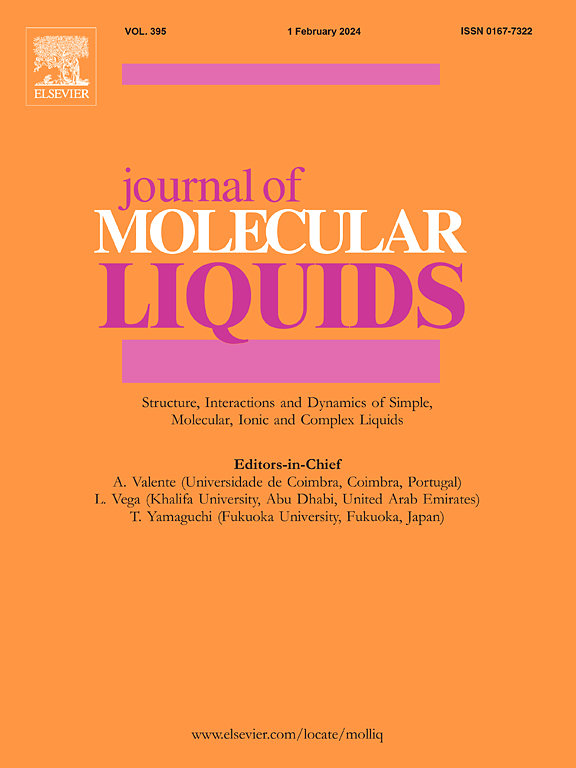Impact of brine chemistry on viscoelastic properties and geochemical interactions of low salinity polymer at rock-brine interfaces
IF 5.3
2区 化学
Q2 CHEMISTRY, PHYSICAL
引用次数: 0
Abstract
Recently, numerous studies have evaluated the efficacy of low salinity polymer (LSP) flooding in sandstone oil reservoirs; however, literature review revealed that the effects of brine chemistry on polymer viscoelasticity, and the subsequent impact on LSP flooding performance need to be clarified. To achieve that, the geochemical interactions of polymer with the rock surface at different brine chemistries and their effects on polymer adsorption and viscosity loss need to be considered. Therefore, the present study aims to investigate the impact of brine chemistry on polymer viscoelasticity, and ion exchange reactions with Boise sandstone cores. A multidimensional experimental approach, including frequency sweep measurements of HPAM polymer solutions at various brine chemistries was employed. Additionally, IC and ICP analyses were conducted for equilibrated brine with Boise rock. Moreover, single-phase displacement experiments were performed to study polymer adsorption and viscosity loss, with effluent analysis carried out using IC and TOC. The results revealed that polymer solutions with low divalent cation (Ca2+ or Mg2+) concentrations (2 mM) exhibited longer relaxation times (up to 12 s−1), indicating higher elasticity. However, as the cation concentration increased from 4 mM to 14 mM, the polymer structure stabilized, and additional Ca2+ or Mg2+ caused a smaller change in relaxation time (decreasing from 1.33 s−1 to 0.56 s−1), and consequently, in viscoelasticity. Additionally, salinity had a stronger effect on HPAM polymer viscoelasticity than specific brine composition, with the charge-screening effect from salt concentration being the primary driver of relaxation time reduction. Similarly, the ionic composition of formation brine had minimal impact on the geochemical reactions of Boise rock with or without polymer, except when Ca2+ and Mg2+ were absent. Moreover, the presence of polymer in the brine was found to affect ion exchange reactions, equilibration processes, and extend the stabilization time during flooding experiments, emphasizing the importance of considering polymer behavior in fluid-rock interactions. Furthermore, the salinity of the makeup brine, rather than polymer concentration, primarily influenced adsorption behavior and injectivity by controlling polymer-rock interactions. Both high salinity polymer (HSP) (5459 ppm) and LSP (545.9 ppm) showed a similar 20 % of viscosity degradation, with delays in viscosity recovery due to polymer adsorption in HSP and salinity changes in LSP, and final degradation driven by increased divalent cation concentration in the water chemistry. These findings emphasize the importance of optimizing polymer formulations based on brine chemistry, managing the salinity of injection water and the presence of divalent cations, and understanding geochemical interactions and flow dynamics to enhance LSP performance and mitigate adverse effects such as scaling and viscosity loss due to brine-rock interactions.
求助全文
约1分钟内获得全文
求助全文
来源期刊

Journal of Molecular Liquids
化学-物理:原子、分子和化学物理
CiteScore
10.30
自引率
16.70%
发文量
2597
审稿时长
78 days
期刊介绍:
The journal includes papers in the following areas:
– Simple organic liquids and mixtures
– Ionic liquids
– Surfactant solutions (including micelles and vesicles) and liquid interfaces
– Colloidal solutions and nanoparticles
– Thermotropic and lyotropic liquid crystals
– Ferrofluids
– Water, aqueous solutions and other hydrogen-bonded liquids
– Lubricants, polymer solutions and melts
– Molten metals and salts
– Phase transitions and critical phenomena in liquids and confined fluids
– Self assembly in complex liquids.– Biomolecules in solution
The emphasis is on the molecular (or microscopic) understanding of particular liquids or liquid systems, especially concerning structure, dynamics and intermolecular forces. The experimental techniques used may include:
– Conventional spectroscopy (mid-IR and far-IR, Raman, NMR, etc.)
– Non-linear optics and time resolved spectroscopy (psec, fsec, asec, ISRS, etc.)
– Light scattering (Rayleigh, Brillouin, PCS, etc.)
– Dielectric relaxation
– X-ray and neutron scattering and diffraction.
Experimental studies, computer simulations (MD or MC) and analytical theory will be considered for publication; papers just reporting experimental results that do not contribute to the understanding of the fundamentals of molecular and ionic liquids will not be accepted. Only papers of a non-routine nature and advancing the field will be considered for publication.
 求助内容:
求助内容: 应助结果提醒方式:
应助结果提醒方式:


